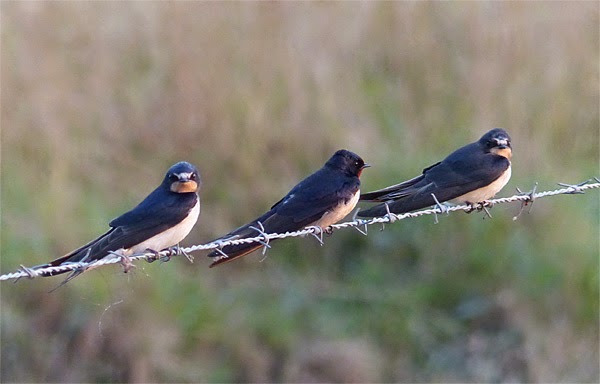The tides weren't ideal but we decided to start this autumns wader ringing sessions anyway. The priority species, as last year, was Common Sandpiper. Any individuals captured were to be colour-ringed in the hope of learning a bit more about their migration patterns, and how they use the marsh. We arrived on site at around 18:30 and went out to set the nets straight away; we intended to put up five nets and on the scrape only.
Once the nets were set it was a waiting game, so we took advantage and did a bit of birding. It was a bit of a breezy evening but there were plenty of Barn Swallows and Common Swifts around to keep us occupied. The swallows were feeding over the meadows and gathering around the reed bed in readiness for roosting.
 |
| Barn Swallows gathering in readiness to roost |
Bearded Tits were very evident in the reed bed, constantly pinging as the flew back a forth across the reed bed. The stream was the best place for waders, with about 25 Black-tailed Godwits, 15 Northern Lapwing, five Common Sandpipers and a couple of Common Redshank and Common Teal.
 |
| Black-tailed Godwits, Common Teal and Mute Swans on the Stream |
As the sun set over Portsmouth Harbour the wind began to drop and the tide neared its peak. The five Common Sandpipers on the stream began to call and circled around before heading out into the mid-marsh.
 |
| Sunset over Portsmouth Harbour |
Our first net round produced two birds, and Dunlin and a Common Sandpiper, both of them juveniles. As I mentioned earlier the Common Sandpiper was a target species for us and was fitted with a combination of colour rings that would allow for the bird to be individually identified in the field.
 |
| Common Sandpiper with colour rings |
This juvenile bird was aged due to the generally brown but extensively buff tips and dark subterminal bands to the upper parts, and the coverts, were brown and with very heavy dark brown and bright rufous-brown barring.
 |
| Juvenile plumage of Common Sandpiper showing extensive barring. |
Our second and final round produced four birds, three Dunlin and a Common Redshank, all the birds were once again juveniles. This time last year we were commenting on how we were only catching adult birds, so it was a refreshing change to be catching juveniles.
 |
| Dunlin |
The chestnut fringes on the wing and body feathers age this bird as a juvenile. Some juvenile feathers will be retained through to the next summer so birds should still be able to be aged up to that point.
 |
| Juvenile Dunlin showing buff fringing to feathers |
The upperparts and coverts of the Redshank were extensively fringed buff and warm brown, thereby ageing it as a juvenile. The bill was a dull reddish colour, darkening towards the tip again a juvenile feature.


No comments:
Post a Comment